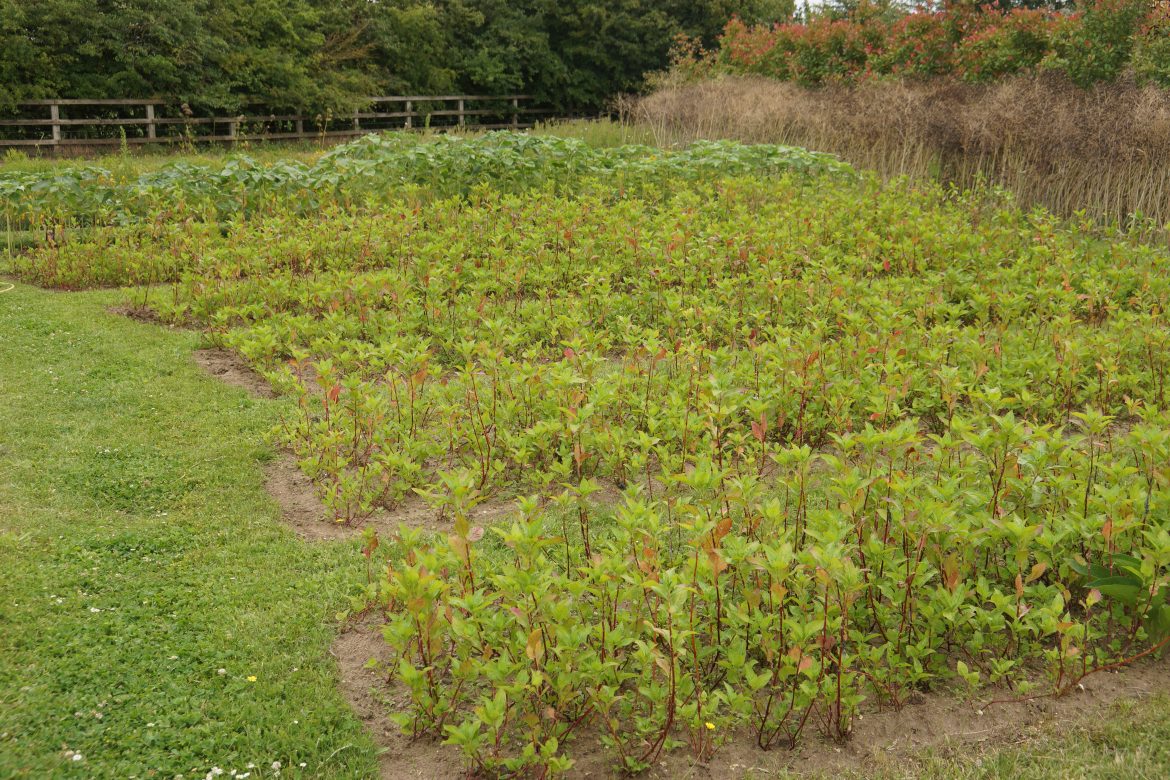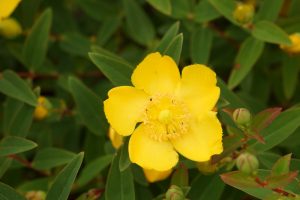
Japanese Indigo
| 6th July 2020The dye garden this week

The Japenese indigo I planted outside 3 weeks ago has taken really well.
JAPANESE INDIGO (Polygonum tinctorium)
It is a member of the knotweed family – although, thankfully not the same plant as Japanese knotweed (Fallopia japonica) which is a weed that spreads rapidly and can be damaging to the environment.
It is an attractive annual with soft green leaves and pale pink flowers that appear in late summer yielding beautiful pure blues.
green leaves and pale pink flowers that appear in late summer yielding beautiful pure blues.
The established plant can be propagated by bending a branch and tucking it into the soil next to the mother plant where it will quickly develop into a new plant. It benefits from a well composted and moist bed.
Harvest leaves from mid-summer to Autumn. The leaves are ready when you pinch the leaves which produce a dark blue stain.
To harvest the indigo, cut a few inches from the ground just before the plant flowers, leaving the root and some foliage. Feed and water the cut plant regularly and the plants will quickly grow back ready for another harvest in about 4 weeks.
Feed your plants regularly as they do require a decent amount of fertilizer. I feed mine with diluted comfrey concentrate (Bocking 14) which we produce in the dye garden and is available online from our sister company cultivated-comfrey.co.uk.
Comfrey is the organic gardener’s best friend. It is loaded with nitrogen, phosphorus, and potassium.
I will talk more on how to dye with Japanese indigo leaves in a future blog.
Fresh seeds are available from dyeing-crafts.co.uk from November.
ALKANET
I must say I am still confused about alkanet. – though I do believe that the seeds I bought from the USA over two years ago may indeed be the long sought after Alkanna tinctoria. It looks very different from the Common Alkanet I am very familiar with (A. Officinalis).
 This is an image of the Alkanet grown from the seeds purchased from the USA believed to be Alkanna tinctoria and apparently quite difficult to source.
This is an image of the Alkanet grown from the seeds purchased from the USA believed to be Alkanna tinctoria and apparently quite difficult to source.
The roots are still small and I don’t intend to attempt to dye with them for another year. However, if anyone has knowledge of this variety I would love to hear from you.

This is an image of our British species, the Common Alkanet which looks very different from what may or may not be the Alkanna. What do you think?
ST. JOHN’S WORT (Hypercium perforatum)
St. John’s Wort has been used since ancient times as a remedy for anxiety and depression, but did you know that the yellow star shaped flowers yield an interesting range of colours from yellow, green, brown and maroon – depending upon the mordant and dyeing technique used.


Gathering the many flowers is very labour intensive.
Apparently the name St. John’s Wort comes from its traditional harvesting on St. John’s Day June 24th which celebrates the birth of John the Baptist. The feast of Saint John closely coincides with the June solstice which is fixed at June 24th.
WOAD (Istatis tinctoria)
I am so excited this years woad plants are ready for their first harvest!
Woad has been used for thousands of years to dye wool and other natural fibres. It is native to Northern Europe and the British Isles. Both indigo and woad provide us with beautiful blue dyes. The chemical which gives the blue dye is called indigotin. The indigo plants yields 10 times more indigotin than woad and are therefore much stronger.
Woad is a biennial. It grows its leaves in the first year in small compact clusters about eight inches in height. It is the leaves that contain the blue dye. In the second year, it grows up to five foot in height.

Woad leaves ready to harvest 1st year


Woad seeds ready to harvest 2nd year
If you enjoy my blog or website please like me on Facebook. I now also have a new Instagram account ………..follow me on Instagram.


